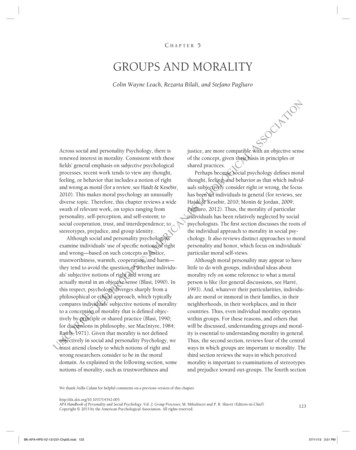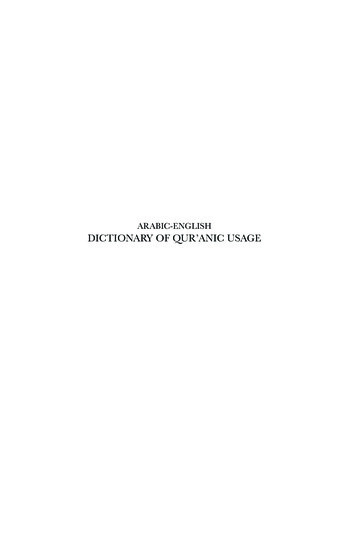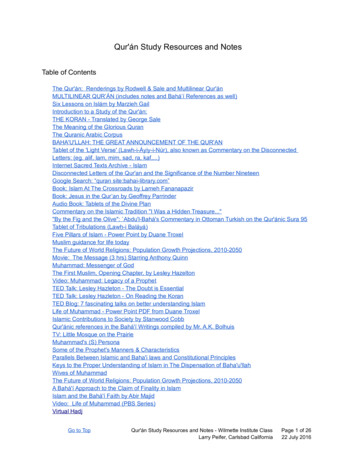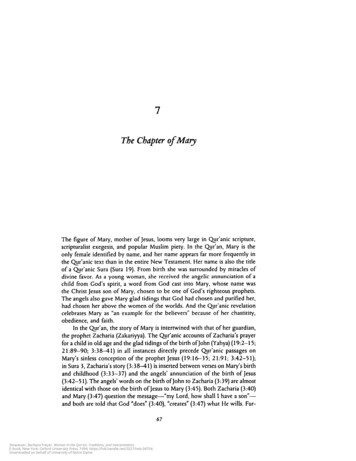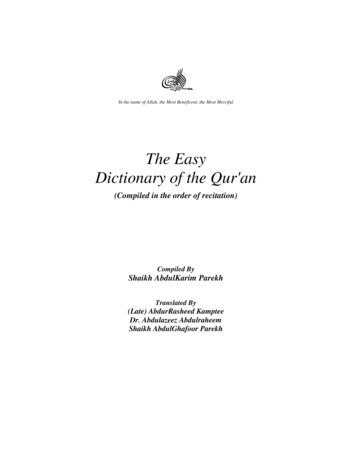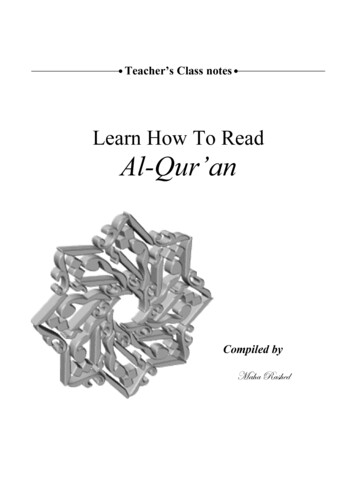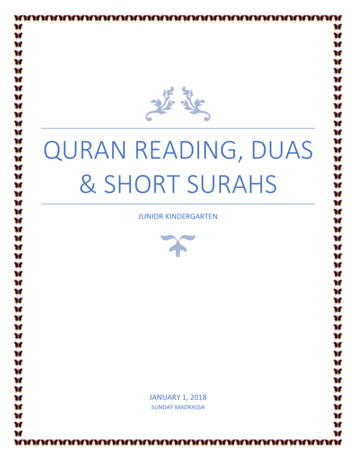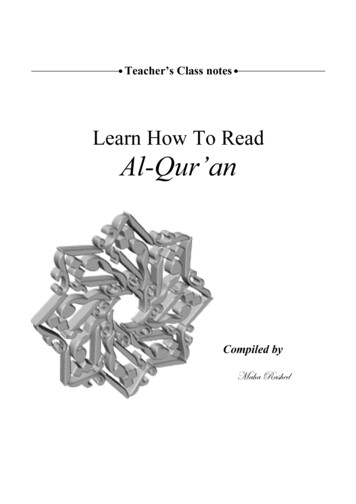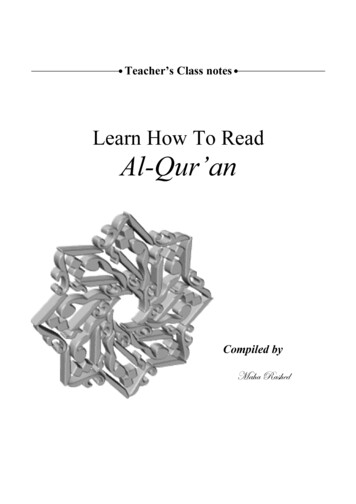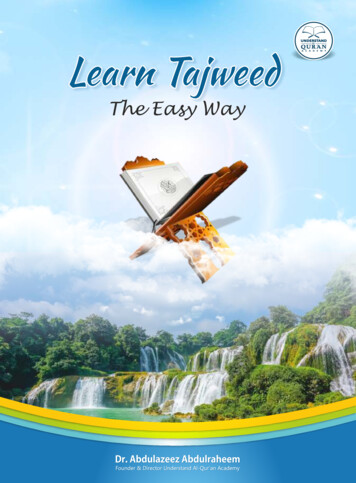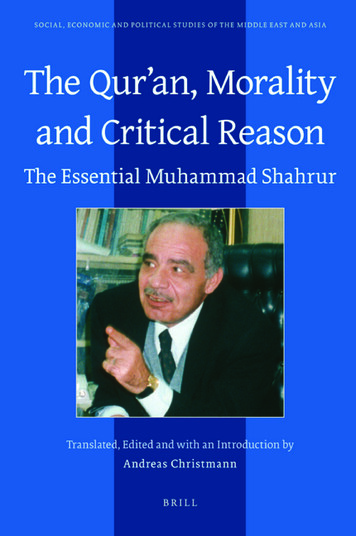
Transcription
The Qur"an, Morality and Critical Reason
Social, Economic andPolitical Studies of theMiddle East and Asia(S.E.P.S.M.E.A.)(Founding editor: C.A.O. van Nieuwenhuijze)EditorDale F. EickelmanAdvisory BoardFariba Adelkhah(SciencesPo/CERI, Paris)Roger Owen(Harvard University)Armando Salvatore(University of Naples “L’Orientale” – Humboldt University, Berlin)VOLUME 106
The Qur"an, Moralityand Critical ReasonThe Essential Muhammad ShahrurTranslated, Edited, and with an Introduction byAndreas ChristmannLEIDEN BOSTON2009
This book is printed on acid-free paper.Cover photo courtesy Dale F. Eickelman. All rights reserved.The publication of this book has been financially supported by the Institute of ContemporaryIntellectual Studies, Beirut – Lebanonand the British Arts and Humanities Research Council (AHRC)Library of Congress Cataloging-in-Publication DataShahrur, Muhammad.[Selections. English. 2009]The Qur’an, morality and critical reason : the essential Muhammad Shahrur / translated,edited, and with an introduction by Andreas Christmann.p. cm. — (Social, economic and political studies of the Middle East and Asia)Includes bibliographical references and index.ISBN 978-90-04-17103-9 (hardback : alk. paper)1. Islam. 2. Islam—20th century. 3. Shahrur, Muhammad—Interviews. 4. Scholars,Muslim—Interviews. I. Christmann, Andreas. II. Eickelman, Dale F., 1942- III. Title.IV. Series.BP161.3.S48213 2009297.2—dc222008049375ISSN 1385-3376ISBN 978 90 04 17103 9Copyright 2009 by Koninklijke Brill NV, Leiden, The Netherlands.Koninklijke Brill NV incorporates the imprints Brill, Hotei Publishing,IDC Publishers, Martinus Nijhoff Publishers and VSP.All rights reserved. No part of this publication may be reproduced, translated, stored ina retrieval system, or transmitted in any form or by any means, electronic, mechanical,photocopying, recording or otherwise, without prior written permission from the publisher.Authorization to photocopy items for internal or personal use is granted by Koninklijke Brill NVprovided that the appropriate fees are paid directly to The Copyright Clearance Center,222 Rosewood Drive, Suite 910, Danvers, MA 01923, USA.Fees are subject to change.printed in the netherlands
table of contentsvTABLE OF CONTENTSForeword by Dale F. Eickelman . . . . . . . . . . . . . . . . . . . . . . . . viiAcknowledgements . . . . . . . . . . . . . . . . . . . . . . . . . . . . . . . . . . xiiiUsed Translations and their Abbreviations . . . . . . . . . . . . . . . xv‘Read the Qur"an as if it was revealed last night’: An introduction toMuhammad Shahrur’s life and work . . . . . . . . . . . . . . . . . . . . . . . . xviiIntroduction by Muhammad Shahrur . . . . . . . . . . . . . . . . . . .1Chapter One . . . . . . . . . . . . . . . . . . . . . . . . . . . . . . . . . . . . . .Al-Isl§m and al- m§n21Chapter Two . . . . . . . . . . . . . . . . . . . . . . . . . . . . . . . . . . . . . .The Sunna of the Prophet71Chapter Three . . . . . . . . . . . . . . . . . . . . . . . . . . . . . . . . . . . . . 115RevelationChapter Four . . . . . . . . . . . . . . . . . . . . . . . . . . . . . . . . . . . . . . 177The Theory of LimitsChapter Five . . . . . . . . . . . . . . . . . . . . . . . . . . . . . . . . . . . . . . 219Women and Islamic LawChapter Six . . . . . . . . . . . . . . . . . . . . . . . . . . . . . . . . . . . . . . . 329Political IslamConclusion . . . . . . . . . . . . . . . . . . . . . . . . . . . . . . . . . . . . . . . . 483Interview with Muhammad Shahrur . . . . . . . . . . . . . . . . . . . . 501by Dale F. Eickelman (1996)Interview with Muhammad Shahrur . . . . . . . . . . . . . . . . . . . . 525by Andreas Christmann (2007)
vitable of contentsGlossary of Terms and Concepts . . . . . . . . . . . . . . . . . . . . . . 537Bibliography . . . . . . . . . . . . . . . . . . . . . . . . . . . . . . . . . . . . . . . . 559Index of Terms and Names . . . . . . . . . . . . . . . . . . . . . . . . . . . . 571
foreword by dale f. eickelmanviiFOREWORD(Dale F. Eickelman)Both mass education and mass communications, particularly theproliferation of media and the means by which people communicate,have profoundly influenced how people think about religious andpolitical authority throughout the Muslim world. Multiple means ofcommunication have eroded the frontier between ‘authorized’ and‘illicit’ communications, making the control of information and opinion much more difficult than it was in prior eras and fostering, albeitinadvertently, a fragmentation of authority and a civil society of dissent. We are only now beginning to understand how differentmedia—print, television, radio, cassettes, music, and the Internet—influence groups and individuals, encouraging unity in some contextsand fragmentation in others, but the written word remains the privileged cultural vehicle for shaping religious beliefs and practicesthroughout the Muslim world. Books and pamphlets, includingbanned ones, are talked about and invoked as authority in sermons,cassettes, lectures, reviews, and conversations. In seeking to ban andconfiscate them, censors only draw attention to their existence andincrease their circulation.At the high end of this transformation is the rise to significanceof books such as Muhammad Shahrur’s. His first major book inArabic, al-Kit§b wa’l-Qur"§n: Qir§"a mu#§ßira [The Book and the Qur"§n](1990), became an unexpected best-seller throughout the Arab worldin spite of its length of over 800 pages and being banned in severalcountries. Four successive books (through 2008) followed, furtherelaborating and articulating his ideas on the state, civil society, anddemocracy in Qur"anic thought, values and ethics in modern society,and the sources of tyranny and terrorism.The Book and the Qur"§n became an instant success, with tens ofthousands of copies sold throughout the Arab world in both authorized (Damascus and Beirut) and pirated (Cairo) editions, and waswidely circulated by photocopy elsewhere (including Saudi Arabia),in spite of the fact that its circulation was banned or discouraged.The impact of Shahrur’s writings, like those of comparable writers,
viiiforeword by dale f. eickelmanis not limited to those who read it. A much larger number of peoplelearned about his book in reviews or rebuttals or in admonitions notto read it. We may live in what sociologist Manuel Castells hasfamously called the era of the ‘network society,’ but the main vehiclefor the spread of Shahrur’s ideas from the outset has been the printedword. The covers of Shahrur’s books are austere, distinctive fromthe eye-catching techniques of modern graphic design. Ironically,only the pirated Egyptian editions show a flair for graphic design.The impact of ideas such as Shahrur’s could not have been imagined before large numbers of people were able to read his books andunderstand his sustained advocacy. Shahrur argues that there is aneed to reinterpret ideas of religious authority and tradition, and toapply Islamic precepts to contemporary society. Yet popular resistance to such challenges to established authority has also beenintense. Dozens of books and many more critical reviews have beenwritten and Friday sermons delivered in response to Shahrur. Thepopularity and appeal of his argument has so infuriated some of histraditionalist detractors that they imitate the cover design of his bookand even insert in their bibliography the number of ‘factual errors’in his essay—‘over 2,500’ by one 1996 account. Such error-countersfail to realize that Shahrur’s goal is to redefine how Muslims andnon-Muslims alike think about religion and sacred authority.From the outset in his writings, Shahrur has made a striking analogy between the Copernican revolution and Qur"anic interpretation.Copernicus (1473–1543) replaced the older Ptolemaic view of a universe in which all celestial bodies revolved around a stationary earthwith one in which the earth revolved daily on its own axis and onceyearly (at least with a solar calendar) around the sun. Shahrur writesthat Qur"anic interpretation has been shackled for centuries by theconventions of medieval jurists, who had mastered the craft of chaining authoritative commentaries to prior authoritative ones and ofcreating genealogies, or chains (silsilas), of traditions of authoritativelearning.Shahrur’s intent is to replace this long tradition with human reason. On issues ranging from the role of women in society to rekindling a ‘creative interaction’ with non-Muslim philosophies, Shahrurargues that Muslims should reinterpret sacred texts anew and applythem to contemporary social and moral issues: “If Islam is sound[ߧliÈ] for all times and places,” then we must not neglect historical
foreword by dale f. eickelmanixdevelopments and the interaction of different generations. We mustact as if “the Prophet just . . . informed us of this Book.”Shahrur’s ideas directly challenge the authority of traditionalQur"anic exegesis (tafsÊr), collections of sayings of the prophet (ÈadÊth),and Islamic jurisprudence ( fiqh). The subtitle of his first book—‘acontemporary interpretation"—uses the term qir§"a, which can meaneither reading or interpretation, rather than the term tafsÊr, whichdirectly evokes the established conventions of traditional Islamiclearning from which Shahrur advocates a decisive break. For manyMuslims and established men of religious learning, Shahrur arguesthat traditional disciplines of learning such as tafsÊr have implicitlyacquired an authority equal to that of the Qur"an itself. As Shahrurexplains, the four conventional schools of Islamic jurisprudence saylittle about tyranny and absolutism, although they deal extensivelywith rules for inheritance and ritual cleanliness.Because Shahrur’s ideas pose such basic challenges to existingauthority, he has been periodically attacked in some Friday sermonsin Damascus since the publication of his first book. As a MuslimBrother said to me in Kuwait in June 1993, Shahrur is “worse thanSalman Rushdie” because he proclaims his faith in Islam but advocates a critical stance toward established conventions of authoritativelearning. The Kuwaiti continued: “Not all Muslims have a high levelof education or an ability to know Islam. That’s why we have committees of properly qualified scholars, to keep such books out of thehands of Muslims who cannot distinguish between Shahrur’s correctunderstandings and deviations, especially his errors on ideas ofwomen and the family.”These attacks on Shahrur are all the more important because hisnotion of disseminating his ideas is almost as formally rigorous asKant’s notion of ‘public’ contained in his essay on the Enlightenment,in which the idea of ‘public’ is the words of a writer appearing beforereaders independent of authoritative intermediaries such as preachers, judges, and rulers. For a long time, Shahrur’s public speakinginvitations were rare. Beginning in the early 1990s, however,he began to grant newspaper interviews in Arabic and English,has appeared on various Arabic satellite channels, and has madepublic presentations in English in North America and Europe. TheArabic appearances are meticulously recorded on his website (www.shahrour.org). Unsurprisingly, the website is austere. It is easy to
xforeword by dale f. eickelmannavigate, but its focus is on the text. This unadorned means of persuasion, however, appeals to a growing educated middle class.Shahrur’s use of the term ‘Copernican revolution’ to emphasizecontemporary innovations in interpreting God’s word contains anelement of hyperbole. The cliché of the Renaissance, itself a nineteenth century term, is that people like Copernicus discarded thedusty parchments of earlier eras to learn ‘directly from nature.’ Inpractice, the revolution wrought by Copernicus and others combinedfirst-hand observations and the careful analysis of received opinionsof the past, made possible through the dissemination of multiple textsthrough printing. The present ‘revolution’ in thinking about Islamis not a complete break with the past. However, the rise in educational levels and the multiple channels of communication have created an unprecedented opportunity for people to talk back toauthorities, both religious and political, and to invest conventionalforms with new meanings and contexts. The field of discourse hasshifted, so that even those who advocate a more exclusively Islamicintellectual development do so in a language and style that assumesbackground knowledge of ideas and institutions which are not distinctively Muslim. The current situation is far different from earliereras, when men of religious learning all read essentially the same‘core’ texts.The Qur"an, Morality, and Critical Reason presents for the first time inEnglish a comprehensive account of Shahrur’s original approach tohow to think about Islam. In preparing the Arabic original of thisbook, Shahrur has naturally drawn on his nearly two decades ofwriting about Islam. In so doing, however, he has gone beyond andcreated a text that is often both new and consistently accessible.In an interview that I conducted with Muhammad Shahrur inDamascus in 1996, published for the first time in this volume, weexplored his original sense of audience. Over the years, Shahrur haslearned to communicate to new and wider audiences. His earlierwritings dealt only obliquely with the rough topics of the world inwhich we live—tyranny and terrorism. His more recent writings inArabic, and this book in English, confront these hard issues headon.The Qur"an, Morality, and Critical Reason is in part a long-term dialogue with Shahrur’s audience in the Arab world, Europe, NorthAmerica, and even Indonesia—where his work in translation hasreceived a wide and appreciative audience. Andreas Christmann,
foreword by dale f. eickelmanxilike myself, saw early on the originality of Shahrur’s work and hisapproach to linking faith to reason. This translation is so clear andeffective that it is at times easy to think that it was written originallyin English rather than translated from Arabic. Christmann’s introduction, like his annotated explanations of Shahrur’s narrative, addsvalue by giving readers an intimate sense of the intricacies ofShahrur’s approach to critical inquiry, the context for the interpretive issues that Shahrur addresses, and a window into the criticaldebates now underway in the Arabic-speaking world.Shahrur’s approach goes to the heart of current debates abouthow to interpret Islam in the modern world. In many respects I findhis approach to thinking about religion and reason the Arabic counterpart to Wilfred Cantwell Smith’s highly influential The Meaningand End of Religion (1962). Shahrur vigorously offers an innovativeapproach to interpreting Islam and its relation to other faiths, prophetic tradition, the controversial ‘limits’ (Èudåd ) of Islamic law,women, and political Islam—including a head-on confrontation withadvocates of tyranny and terrorism.In The Qur"an, Morality, and Critical Reason Shahrur boldly confrontscontroversial issues and at the same time links the fundamentals offaith—and not just Islamic faith—to critical reason. He offers astrong argument for a civil society that encompasses both Muslimsand non-Muslims alike. This book is a portal to his thought for theEnglish-speaking world, and Andreas Christmann’s superb introduction and annotated translation makes it an exciting and accessiblepoint of departure for Shahrur to engage a wide audience in theEnglish-speaking world.
xiiforeword by dale f. eickelman
foreword by dale f. eickelmanxiiiACKNOWLEDGEMENTSSince this book is a compilation of texts which have been specificallyrearranged and modified for this translation, it could not have beendone without a considerable amount of collaboration with MuhammadShahrur and those people around him who support his work. I wishto thank Muhammad Shahrur for the time he spent with me explaining his thoughts in the most patient and scholarly manner. I alsothank Sultan al-#Awa for his superb managerial skills in arrangingthe meetings between Muhammad Shahrur and me in Damascusand Abu Dhabi; Mayada al-Kayali and Randa al-Sahli for theirtremendous efforts in selecting and arranging with me the Arabictexts from Shahrur’s monographs, journal articles, interviews, andconference papers; MuÈammad JamÊl al-Qaßß§ß for his IT-support;Muhammad Khaled and Mustafa Baig for their help and assistancein the Department of Middle Eastern Studies at ManchesterUniversity; my colleague Ronald Buckley who read drafts of thisbook and made numerous invaluable corrections and improvements;Dale F. Eickelman who was of tremendous support and encouragement throughout the entire project; Dawn Hall for her excellentcopyediting; my daughter Sophia for helping me to draw up thecharts; my daughter Dorothea for always being ‘eine fest Burg’; andmy wife Kerstin for her meticulous proofreading of the manuscriptand her unwavering support.A substantial part of the work on this book was done during myresearch leave, supported by the British Arts & Humanities ResearchCouncil in 2007–08. I sincerely appreciate the help and supportI received through this research-leave scheme.
xivforeword by dale f. eickelman
abbreviationsxvUSED TRANSLATIONS AND THEIR ABBREVIATIONSYAYusuf Ali, The Holy Qur"an: English Translation of the Meanings and Commentary(Medina: King Fahd Holy Qur"§n Printing Complex, 1410 AH/1990).AHM.A.S. Abdel Haleem, The Qur"an (Oxford: Oxford University Press,2005).MFMajid Fakhry, An Interpretation of the Qur"an: English Translation of the Meanings(New York: New York University Press, 2000).MPMuhammad Marmaduke Pickthall, The Meaning of The Glorious Qur"an: AnExplanatory Translation (New Modern English Edition, Birmingham: IslamicDa"wa Centre International, 2004).ABAbdalhaqq and Aisha Bewley, The Noble Qur"an: A New Rendering of ItsMeaning in English (Norwich: Bookwork, 1999).AhAAhmad Ali, Al-Qur"§n: A Contemporary Translation (Princeton: PrincetonUniversity Press, 2001).AAArthur J. Arberry, The Koran Interpreted, 2 vols. (London: George Allen &Unwin, 1963).Muhammad Shahrur’s frequent use of quotations from the Qur"anwas a particular problem in the English translation, as his understanding of the Arabic text differed considerably from most availableEnglish translations. After consultation with Muhammad Shahrur,it was decided to use Yusuf Ali’s version as the default translation inthe main text, but it was felt unnecessary to replicate Ali’s antiquateduse of English personal pronouns (thy, ye, thou, etc.) and his frequentuse of capital initial letters for terms he felt had a particular spiritualresonance. However, in instances when Ali’s translation was eitherincomprehensible or completely inadequate to render Shahrur’sunderstanding of a verse, I have sought help from other translations,in particular from Abdel Haleem’s rendering. I have consulted sixof the most commonly used English translations from a variety ofdifferent linguistic, religious, and educational backgrounds. I indicatein footnotes where discrepancies between their translations andShahrur’s interpretations occur. In some instances, however, whereno translation seemed to offer any resemblance to Shahrur’s readingI have decided to use my own version based on what I thought wasthe author’s purpose in quoting a specific verse. In situations whereI thought it was vital to stress the disagreement between Shahrur’sreading of a verse and its common rendering (including those by
xviabbreviationsEnglish translators), I have kept Ali’s version but inserted the Latinabbreviation [sic] in order to highlight Shahrur’s explicit disagreement with such renderings which he regards as erroneous. When theauthor has not produced an explicit alternative meaning of a wordwhose common understanding he heavily criticises, the word in question has not been translated but rather replaced by suspension pointsin square brackets [ ], followed by Shahrur’s commentary after thequotation of the verse.
muhammad shahrur’s life and workxvii‘READ THE QUR"AN AS IF IT WAS REVEALED LASTNIGHT’: AN INTRODUCTION TO MUHAMMADSHAHRUR’S LIFE AND WORKThis edition assembles the essential writings of Muhammad Shahrur,one of the most interesting and innovative thinkers in the contemporary Arab-Muslim world. The success of his first book on Islam,The Book and the Qur"§n: A contemporary reading (1990),1 made him ahousehold name among intellectuals, students, and scholars of theentire Middle East during the 1990s. Many readers were stunned bythe bold, creative, and unfamiliar way of thinking that characterisedShahrur’s writings. People who were neither experts nor full-timestudents of Islam and the Qur"an were fascinated by the logic of hisarguments and gained easy access to rather complex philosophicaland theological debates. My own first encounter with his work cameduring my fieldwork for my PhD thesis in the mid-1990s in Damascus,when I witnessed what Peter Clark, back in 1996, had called ‘theShahrur phenomenon’: the publication of an extraordinary book that“challenges a millennium of Islamic tradition”.2 The unusual composition of the book, its peculiar Arabic style, and its original wayof presenting logical arguments were so unique that in 1997 WaelHallaq emphatically stated that the book “is impressive in that itoffers both depth and range, virtually unparalleled in modern writings on the subject”.3 The enormous number of copies sold, the speedby which reprints were issued and pirate versions reproduced, andthe extent to which the book’s ideas were circulated in the preInternet 1990s throughout the Middle East inspired Dale F. Eickelmanin 1999 to argue that the Shahrur phenomenon reflected the factthat in most Muslim countries a reconfiguration of the ‘public sphere’can be witnessed, not only in terms of different communication1MuÈammad ShaÈrår, Al-Kit§b wa’l-qur"§n—Qir§"a mu#§ßira (The Book and theQur"an: A Contemporary Reading), (Damascus: D§r al-Ah§lÊ li’l-Nashr wa’l-TawzÊ#,1990).2Peter Clarke, “The ShaÈrår Phenomenon: A Liberal Islamic Voice fromSyria,” Islam and Christian-Muslim Relations 7, no. 3 (1996): 337–41 (337).3Wael Hallaq, A History of Islamic Legal Theories: An Introduction to SunnÊ ußål al-fiqh(Cambridge: Cambridge University Press, 1999), 246.
xviiiintroductionchannels used and different kinds of topics publicly discussed butalso in terms of the type of actors who now enter the public debateabout Islam and the type of listeners/readers who participate in it.The book’s success, Eickelman says, “could not have been imaginedbefore there were large numbers of people able to read it and understand its advocacy of the need to reinterpret ideas of religious authority and tradition and apply Islamic precepts to contemporarysociety”.4By the time I seriously began to consider Shahrur’s œuvre in 2001,three more books had appeared,5 and Shahrur was already workingon his fifth book, which he eventually finished in 2007 and publishedin 2008.6 Thus, it has become clear that ‘the Shahrur phenomenon’cannot be reduced to the appearance of only his first book but needsto be explained in a more comprehensive way by covering his otherwritings as well. This volume is an attempt to present Shahrur’sentire œuvre in a single book, covering almost two decades of hispublications and (almost) the entire spectrum of his thought. It ishoped that this selection, translated and specifically arranged for anEnglish-speaking readership, with the approval of the author, willhelp the English reader to understand what has captured the publicimagination of Arab readers in the 1990s and, beyond that, whyShahrur’s work has been perceived by some as so emphatically revolutionary that Eickelman concluded that “compared to most otherIslamic thinkers, Shahrur is a radical”, 7 while others, like RainerNabielek, even compared his ideas to the Ninety-Five Theses that4Dale F. Eickelman, The Coming Transformation of the Muslim World. The 1999Templeton Lecture on Religion and World Affairs (June 9, 1999).5Shahrur wrote his second book in 1994, entitled Dir§s§t isl§miyya mu#§ßirafi’l-dawla wa’l-mujtama# (Contemporary Islamic Studies on State and Society), inwhich he applies his methodology and the evolutionary philosophy of human knowledge, as developed in Al-Kit§b wa’l-qur"§n, to the sphere of Islamic politics, arguing forthe need drastically to revise its traditional understanding. In 1996, he wrote al-Isl§mwa’l- m§n (Islam and Faith), and finally, in 2000, he published NaÈw ußål jadÊda li’l-fiqhal-isl§mÊ (Towards New Foundations of Islamic Jurisprudence), in which he presentsa more systematized and considered version of his Èudåd theory from Al-Kit§b, appliedto Islamic family law and law of inheritance. He also gives a clearer account of hisviews about the historicity of the Prophetic Sunna, which he takes as the startingpoint to revolutionize Islamic fiqh.6MuÈammad ShaÈrår, TajfÊf man§bi # al-irh§b (Draining the Sources of Terrorism),(Damascus: D§r al-Ah§lÊ li’l-Nashr wa’l-TawzÊ#, 2008).7Dale F. Eickelman, “Muhammad Shahrur and the Printed Word,” ISIM Newsletter 7 (2001): 7.
muhammad shahrur’s life and workxixMartin Luther nailed to the door of the Wittenberg church in 1517,thereby starting the Protestant Reformation.8 The following essaywhich contains a brief summary of Shahrur’s intellectual life and ashort explication of his major streams of thought provides readerswith a first orientation before they embark on the main text ofShahrur’s writings.Life and WorkMuhammad Shahrur was born in 1938 in the ‘§liÈiyya quarter ofDamascus, the capital of Syria. He was the fifth child of a Sunnidyer who decided not to send his son to the local kutt§b and madrasa,but to the secular primary and secondary state school in al-MÊd§n,the southern suburb of Damascus outside the walls of the old city.Shahrur’s childhood was thus spent in a liberal atmosphere in which,even though his father observed the rituals of prayer and fasting andwent with his son on the \ajj in 1946, pious ritual observance wasseen as less important than the ethical teachings of Islam. His fathertaught him that the goodness of a religion can only be measured byits practical and moral implications, not its spiritual efficacy. In areminiscence, given in an interview in 1996, Shahrur fondly recalledhow his father had pointed to the stove of the house and said: “ifyou want to warm yourself, don’t recite the Qur"an, but light a firein the stove.”9Shahrur’s most formative years coincided with the politically mostunstable periods of the Syrian Arab Republic after it gained its independence in 1947. The young Shahrur was, first as a pupil of thenatural sciences then as a student of civil engineering, directly andindirectly influenced by the political turmoil (between 1946 and1956, Syria had twenty different cabinets and four different constitutions), administrative instability (there were ten successful coupsd’état between 1949 and 1970), and the ideological chaos thatresulted. In 1959, after the Soviet Union became a key ally of Syriain 1955, Shahrur was sent to Saratow, near Moscow, to study civil8Rainer Nabielek, “Muhammad Shahrur, ein ‘Martin Luther’ des Islam,” inamo23/24, no. 6 (Autumn and Winter 2000): 73–74, and Dale F. Eickelman, “Inside theIslamic Reformation,” Wilson Quarterly (Winter 1998): 86.9The full transcript of the interview can be found in this volume on pages501–523.
xxintroductionengineering. There he experienced another phase of political andideological confusion. While witnessing the dismantling of Stalinismduring Nikita Khrushchev’s reign as Soviet Prime Minister (1958–64),his religious beliefs were challenged by a confrontation with Marxistphilosophy and institutionalised Soviet-style atheism. Sharing withmany contemporary foreign intellectuals the disillusionment with theone-party rule and totalitarian tendencies of the Communist Partyof the Soviet Union, he still battled with atheism and was—accordingto his memories—so involved in defending his theistic beliefs that allother questions of religion seemed irrelevant to him.10 When hegraduated in 1964 with a diploma from the Moscow Institute ofEngineering, fluent in Russian and married to a Russian wife whobore him a son, he returned to Syria. A couple of years before hisreturn, the political union between Syria and Egypt (1958–61) hadbeen buried along with any hope for a pan-Arab union. Trying toexplain the underlying reasons for such political failure, Shahrurbelieved that pan-Arab thought had failed to produce the necessaryideology for a political union as it was too immersed in romanticistnostalgia entrenched in sentimental poetry. His encounter withMarxist philosophy had taught him that any viable ideology neededa fundamental concept of knowledge, that is, a theory about thehuman perception of things that exist in objective reality. He wasdetermined to put this right with his own philosophical ideas.Yet at this point in Shahrur’s development, the prospect of a goodcareer as a civil engineer and all that this required, in particular themastering of mathematics and analytical geometry, proved moreattractive to him than his philosophical interests. Thus, in 1968, heleft Syria again to study abroad, this time at the University Collegein Dublin where he earned his master’s degree in 1969 and his doctoral degree in soil mechanics and foundation engineering in 1972.Eventually, he went back to Damascus University, where he lecturedas a mudarris, then as an assistant professor before being made a fullprofessor at the Faculty of Engineering. He taught at DamascusUniversity for twenty-six years, from 1972 to 1998, and becamerenowned as the author of several Syrian standard reference workson soil mechanics and foundation engineering. Beside his teachingobligations he worked as a consultant engineer supplying inspectionservices for over two thou
and Islamic jurisprudence (fiqh). The subtitle of his first book—‘a contemporary interpretation"—uses the term qir§"a, which can mean either reading or interpretation, rather than the term tafsÊr, which directly evokes the established conventions of traditional Islamic learnin
